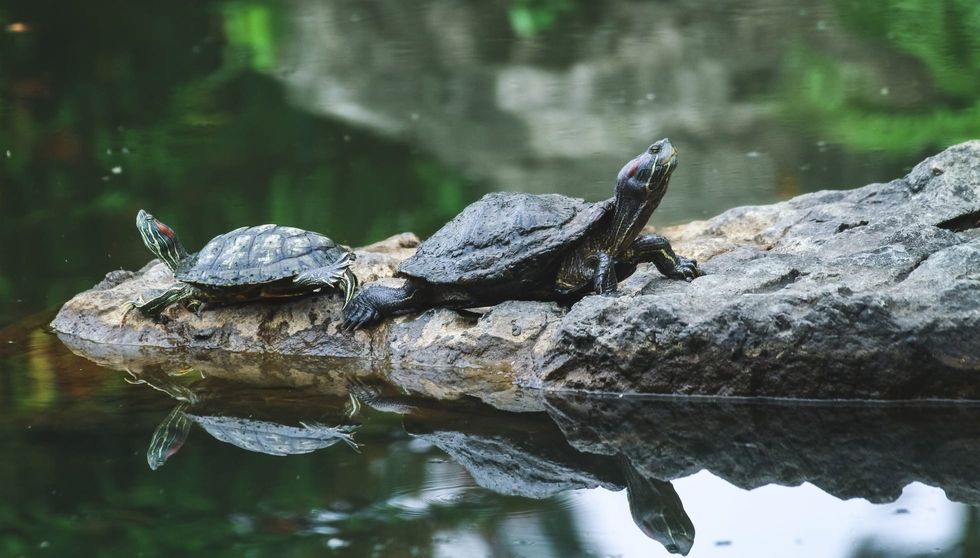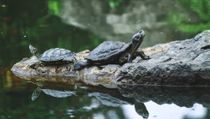The Chinese pond turtles, also called the Reeve's turtle, can be found in several places in China. These reptiles are semiaquatic and can be found roaming on the land to bask in sun on rocks and also in waddling pools and abundant water bodies.
They usually basking in shallow ponds, marshes, and muddy bottoms of streams and canals. They are also known as the three-keeled turtles of China because of their three long distinct keels. They have webbed feet and long tails with stripes on their head.
They have a yellowish body and black terrapin and a rectangular carapace. They are omnivorous and they are fond of worms.
These turtles are the most commonly found species from Shang dynasty sites and they may have been used for divination. These species have a tendency of mating with other species of the same family 'Geoemydidae', and producing hybrids. More similar to turtles one can look for are leatherback sea turtle and olive ridley sea turtle.
Chinese Pond Turtle Interesting Facts
What type of animal is a Chinese pond turtle?
Mauremys reevesii species is a type of turtle found in the eastern Asian region like China, Japan, North Korea, South Korea, and Taiwan.
What class of animal does a Chinese pond turtle belong to?
Reeve's turtle (Mauremys reevesii) belongs to the reptilia class of animals.
How many Chinese pond turtles are there in the world?
There are 10,000-1,000,000 Reeve's turtles in the world. According to the Department of Fish and Wildlife U.S., their population is decreasing every year and they are now an Endangered species.
Where does a Chinese pond turtle live?
Reeve's turtle lives in shallow water bodies like ponds, marshes, canals, and streams in soft bottoms covered with mud and sand. They can be found in China, Japan, North Korea, South Korea, and Taiwan.
What is a Chinese pond turtle's habitat?
The best habitat for Reeve's turtles (Mauremys reevesii) are waddling pools and koi ponds as they are not good places to swim. They can also be found in shallow water bodies with soft bottoms.
This species of turtle likes to basking in the sun on rocks in ambient air temperature and they are often found to come out of the water to do so.
The Chinese three-keeled pond turtle likes to live in undisturbed aquatic vegetation. They can also live in a tank as pets with proper light, temperature, and surroundings.
Who do Chinese pond turtles live with?
Reeves lives in their preferred aquatic or terrestrial habitat including their basking area in the wild and also as pets with humans.
How long does a Chinese pond turtle live?
Reeves can live up to 10 to 15 years. With good care, they can survive for 20 years. But in the present days, they are an Endangered species and are on the IUCN Red List.
How do they reproduce?
The Chinese three-keeled pond turtle species have a tendency of hybrid breeding. They tend to mate with turtles of other species. The female Reeve's turtles are innovative when it comes to mating in spite of their small size.
They look for cordial partners. Their breeding season starts in spring and continues till late summer. The Chinese pond turtle eggs are laid on land and not in water.
What is their conservation status?
Reeve's turtles (Mauremys reevesii) are considered Endangered by the IUCN (International Union for Conservation of Nature). They are over-hunted by pet red-eared sliders.
Reeves are hunted for the pet trade and their plastrons are used as an ingredient for traditional China's medicine. There is hope for their preservation as they can breed properly in captivity as well. They are in the IUCN red list.
Chinese Pond Turtle Fun Facts
What do Chinese pond turtles look like?
They are usually small in size and can be from 6-9 in (15-23 cm). Female Reeves have a larger size than male Reeves when they become fully grown adults.
The Reeve's turtle's plastron is more rectangular and wide than the regular round plastron or carapace of other turtles and are olive green in color and the shade of the carapace or shell varies from a dark tan color to black sometimes and it has three longitudinal keels.
They have a black terrapin and a yellowish-brown to dark brown plastron and blotched scutes.
Their neck and head have yellow stripes but there are no stripes all over the body. Their shells can be cream or yellow.
How cute are they?
Reeve's turtles are very cute. This turtle's small size and friendly nature make them look adorable. They are great as pets because they are intrigued and social. Their appearance and good behavior are reasons for them being a popular choice as turtle pets than any other turtle.
How do they communicate?
Reeve's turtles are not very good at speaking as they lack vocal cords. Although, they found a way to communicate using nonvocal communication to express their feelings. They can make hissing sounds and other low-frequency noises.
How big is a Chinese pond turtle?
Reeve's turtles are small-sized, they are generally 6 in (15 cm) in length. When they reach adulthood they reach 9 in (23 cm) in length. Chinese pond turtle females are larger than males when they are full grown. They are twice as bigger as box turtles and map turtles.
How fast can a Chinese pond turtle move?
Reeve's turtles (Mauremys reevesii) can walk at an average speed of 2 mph (3.2 kph) and can swim at a speed of 10 mph (16 kph). They are usually slow but can swim at a speed of 19 mph (30 kph) if they are scared.
How much does a Chinese pond turtle weigh?
The female Chinese pond turtle size varies from 0.4-1.1 lb (0.2-0.5 kg), which is more than males, thus females weigh more than males.
What are the male and female names of the species?
There are no known names for males and females species separately, but they have different names such as Chinese pond turtle, Reeve's turtle, three keeled pond turtle of China.
What would you call a baby Chinese pond turtle?
The baby Reeve's turtle (Mauremys reevesii) is known simply as a hatchling and should not be put under 2 in (5 cm) deep water as they are weak swimmers. They can also be called just baby turtles.
What do they eat?
Reeves turtle are omnivorous in nature, hence their diet consists of both animals and vegetables. They prey on worms, small fish, and insects when they are available.
Their diet also include green leafy vegetables, mole cricket, mormon cricket and like to mess with water lettuce, duckweed, plants and water hyacinth. More importantly, they try to avoid beet plants and spinach. The Chinese pond turtle diet also consists of water hyacinth.
Are they dangerous?
They are not really dangerous in nature, rather they are very cute. They are friendly in nature and are well behaved. They do not cast any kind of threat to any other animals or humans. They are completely sociable.
Would they make a good pet?
Reeves turtles make really good pets. These palm-sized turtles are inquisitive, and their adorable habits make them a favorite among people to roam around their household. Their pleasant nature and purposeful appearance make them an excellent choice of pet. They cost about 12$.
Did you know...
They are omnivores and eat almost everything under the water like plants, worms, water lettuce and duckweeds as they cannot swallow air so they cannot eat in their aquatic habitat.
Do Chinese pond turtles like to be handled?
Yes, as their length is not much and is pretty self-maintained they can be handled easily. Although handling the babies should be done with care as they require constant attention and nourishment.
Having your own Chinese pond turtle?
The Reeves turtle is a little bit more expensive than other turtles but they are worth the money. They are adorable and make excellent pets to keep in tank.
Chinese pond turtle care requires low maintenance. The hatchlings should be fed once a day and should not be overfed. They should be kept in the slightly warm water and the temperature should be in 70-80 F (21-27 C) and should be provided a basking area around 80 F (27 C).
Adult turtles are omnivores and are not picky eaters. So one may feed them with worms, crickets, small plants or lettuce.
Here at Kidadl, we have carefully created lots of interesting family-friendly animal facts for everyone to discover! For more relatable content, check out these Florida softshell turtle fun facts and hawksbill sea turtle surprising facts pages.
You can even occupy yourself at home by drawing one on our free printable Chinese pond turtle coloring pages.










